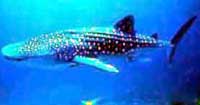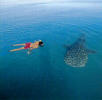|
The gentle Giants from Donsol - Whale Sharks
So or similarly so could the experience of an encounter with a whale shark near the coast of Donsol. To meet a whale shark is surely a rare evidence, however, now such encounters could almost be scheduled, since in 1968 the town of Donsol in the province of Bicol became a Mecca. Before this small town was nearly unknown. Certainly ... there have always been "butandings" - so the local name for the whale shark - in the waters of Donsol, which has a lot of plankton materials. Some fishermen tell about the ride on the back of the big animals. In the area of Donsol the fishes never have been hunted systematically, even if they destroyed sometimes fishing nets and screw propellers. In other areas for example, in the province of Bohol, there was a traditional hunting of these animals with the help of spears, gaffs or .. dynamite. The town of Donsol became known to the public, when in January 1998 a diving-team published pictures of a group of animals and the WWF and officials became aware of these animals, threatened of extinction. However, whalers from the Visayas province and whale meat traders took also notice of the pictures. The result was the killing (with permission of local barangay chief ) of six whales within two weeks shortly after the "discovery". The WWF of Philippines then mobilized the public and specific regulations in favour of the animals and its pasture-area in Donsol were issued. We come back to that issue. Simultaneously first steps have been taken to establish cautiously an ecotourism with the help of local initiatives in Donsol. Up to this date the town of Donsol with its 36,000 inhabitants was only known as a small centre of agriculture (e.g. its "pili-nuts") and as a fishing place. According to some authors it was a sleepy place without any highlights. Arrival Donsol is situated about 540 kilometres south of Manila in the poverty-stricken province of Bicol. The town can be reached by bus and / or airplane. The bus from Manila needs about twelve hours. The fifty-minute flight to Legaspi followed by a one-hour bus ride from Legaspi to Donsol seems to be more favourable for tourists. Not advisable is the route Legaspi Pio Duran because of still bad road conditions. Accommodation and visiting programs can be booked either in Legaspi or Donsol (Donsol Tourism Officer: ( (+63-56) 421-3180). There are also package offers varying in price according to the number days and the size of the visitor group. The diver, photographer and author Juergen Freund ( http://www.scubayyogi.de ) has a good name and is offering in the month of March four times a professional 5-day program from Legaspi. The price is about 570 US$ (2001). Visitors have to pay a local registration-fee (including a picture-show) of 300 pesos, the costs for a day tour with fishing boat and two officials companions ("Tour guide" and "Spotter") are approx. 2500 Pesos. By its infrastructure the town is not prepared for a lot of tourists. Round about 80 beds are offered. Jens Peters recommends in his excellent travel guide the guesthouse "Visitor's Inn" and the Cottage "Amor Farm Beach Resort". A good reputation has also the lodge "Santiago's Home stay", managed by the former English teacher Iderlina Santiago. We recommend the new established beach resort "Woodland", which is a small distance outside of Donsol. Even if the service is still a bit clumsy and sometimes oil spots from incoming boats can be seen, it offers for this region probably the best conditions of staying. The whales are appearing from January to May, most of them in the running of March. As they follow no tourist schedule, there is no absolute guarantee for encounters. The Freund team observed in the months March / April 2001 between 0 - 30 animals per day, the average per day was six animals. Reported maximum is 57 animals. The WWF calculated a probability of 85 % to see at least one animal. A visit in the month of March is recommended because the dry season offers a better visibility (10 - 20 meters). Biology
The thick skin of the whale shark is darkly blue-grey and shows a drawing of yellowish-white spots and vertical lines on the head, back and the flanks. The skin can show injuries in particular from propellers of ships. The eyes are small, the large mouth, however, has a width of up to two meters. The aperture of the broad mouth, having some tooth lines, is not below, but in front. With its mouth which is enable to chew or to bite, the fish sucks sea water in huge quantities. Gill weirs filter primarily plankton, but also shrimps, anchovies, crabs and sometimes little fishes out of water. The whale shark has two pectoral fins in gill height and two dorsal fins. The caudal fin is enormous and protrudes out of water, if the animal is near the surface of water. Sightseeing
There are some regulations in order to protect the endangered animals. Only one boat should have access to a whale. Scuba diving is not allowed, only the use of a snorkel mask. Hectic movements should be avoided. No flash light under water. Touches of the whale, the riding on the whale or clinging at fins are prohibited. Some divers nevertheless, contravene these regulations in order to get "phenomenal" pictures. Whale watching - especially if you are looking for bigger animals - needs patience and luck. Sometimes it is necessary to wait for hours. Therefore, it is recommended to have some lecture and also sun-cream. If the whale is sighted, the snorkel mask and fins must be quickly available. Who wants to avoid the contact with the "the unknown phenomenon" can stay on the boat. A certain thrill is also given on boat, especially if there is a close contact with the boat. According to the mood of the animals, the encounter with the animals can last minutes or up to an hour. Necessity for shelter Against the protest of some fishermen in particular on Bohol, which referred to traditional rights of catching, the Philippine government enacted in 1998 a decree which puts the whale shark under special protection. It forbids the catch of whale shark (as well as sting rays), selling, buying and transport of parts of meat. Counteracting can be punished with at least 500 pesos, at most 5,000 pesos, prison or loss of commercial license. There are numerous experts considering these sanctions not severe enough. These experts refer to the high and attractive prices, which are paid for the fins, the meat and the skin of the whales especially outside of the Philippines. The fins are regarded as a aphrodisiacal delicacy, but the whale itself has only a small reproduction rate. Fins are on Taiwan, in Hong Kong and Singapore and now also in Red China in" and a symbol for higher social status. There is an increasing demand for the meat which is prepared as little fish balls or boiling meat. It is reported that the whales killed 1998 at Donsol were sold for 10,000 per fish and resold in Taiwan for 800,000 pesos. Its evident that such high prices provoke poaching of whales. The fishermen of Donsol show an exception of the rule. No further cases of poaching are reported. The integration of fishermen into the concept of ecotourism and their seasonal incomes resulting from tourism are giving a safeguard for the endangered animals at this place. Beatus locus Donsol. © Wolfgang Bethge, 2003 |


 The whale shark (Rhincodon typus) is regarded as the
biggest fish in the world and can reach a length of up to twenty meters and a
weight up to forty tons. It is very similar to a whale,
nevertheless, it belongs as a cold-blooded, egg-producing non-mammal animal to
the family of sharks. It is a peaceable gentle giant, there are no reports of
killing man. They are living together in schools and are constantly on search
of food in the warm waters of the equator belt. The migration routes, mating
behaviors and birth frequencies are only partially known. They need approx.
thirty years to reach sexual maturity, the maximum life expectance is supposed
to be hundred years. The inseminated eggs are growing in
the uterus of the mother animal which is bigger as male animal - and leave
the body - in a kind second birth -, if the development
is completed.
The whale shark (Rhincodon typus) is regarded as the
biggest fish in the world and can reach a length of up to twenty meters and a
weight up to forty tons. It is very similar to a whale,
nevertheless, it belongs as a cold-blooded, egg-producing non-mammal animal to
the family of sharks. It is a peaceable gentle giant, there are no reports of
killing man. They are living together in schools and are constantly on search
of food in the warm waters of the equator belt. The migration routes, mating
behaviors and birth frequencies are only partially known. They need approx.
thirty years to reach sexual maturity, the maximum life expectance is supposed
to be hundred years. The inseminated eggs are growing in
the uterus of the mother animal which is bigger as male animal - and leave
the body - in a kind second birth -, if the development
is completed. Strangers to the locality of Donsol should engage for their
information and support tourist guides. There are thirty trained
"BIOS" (Butanding Interaction Officers). One is
navigating the boat, the other is a "spotter", looking for whales.
BIOS are mostly native fishermen, which can also give advices with regard to
approaching and diving. The boats have up to six tourists and are on the
coastal sea from morning to afternoon.
Strangers to the locality of Donsol should engage for their
information and support tourist guides. There are thirty trained
"BIOS" (Butanding Interaction Officers). One is
navigating the boat, the other is a "spotter", looking for whales.
BIOS are mostly native fishermen, which can also give advices with regard to
approaching and diving. The boats have up to six tourists and are on the
coastal sea from morning to afternoon.